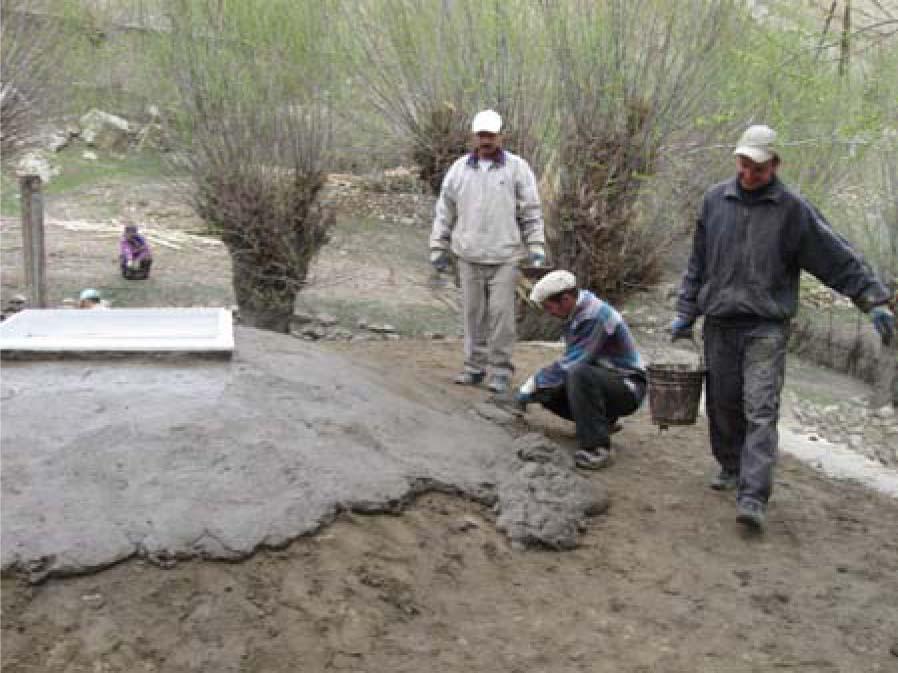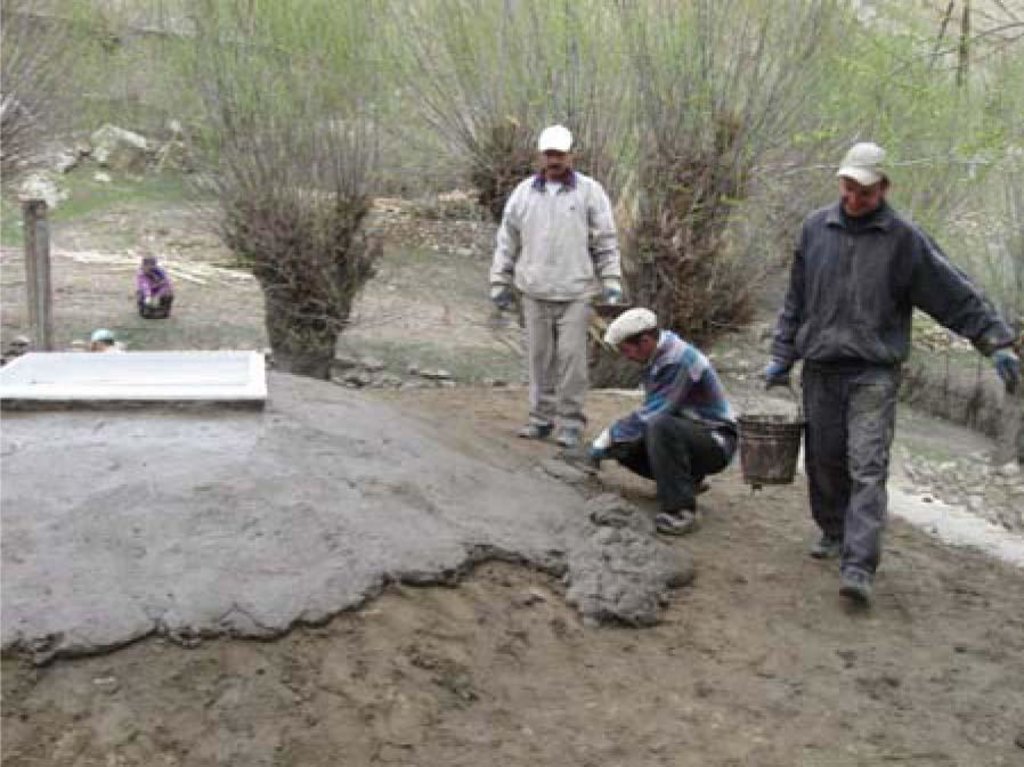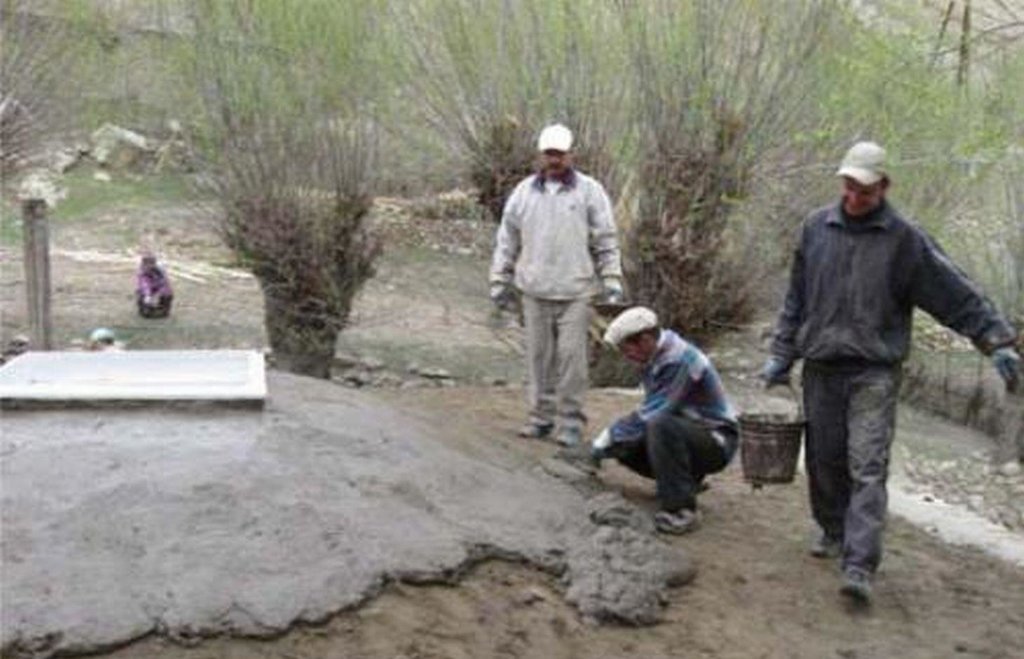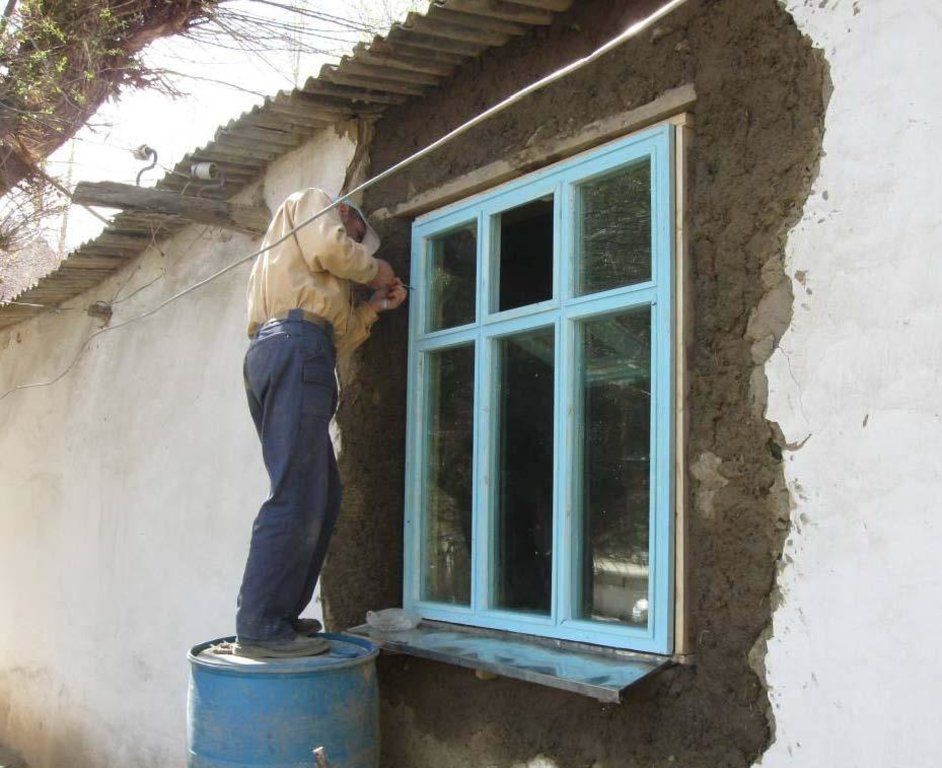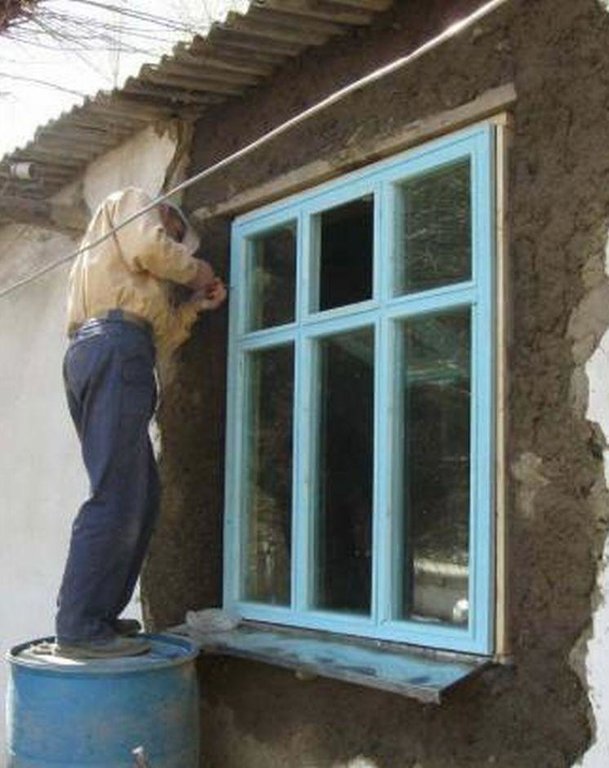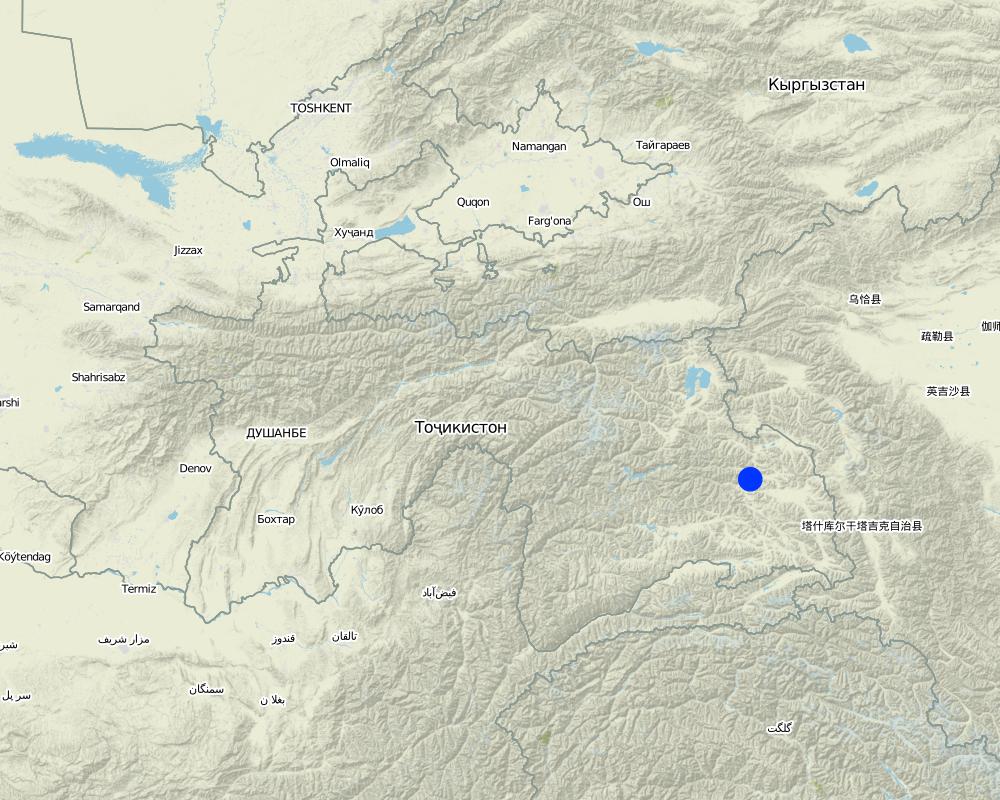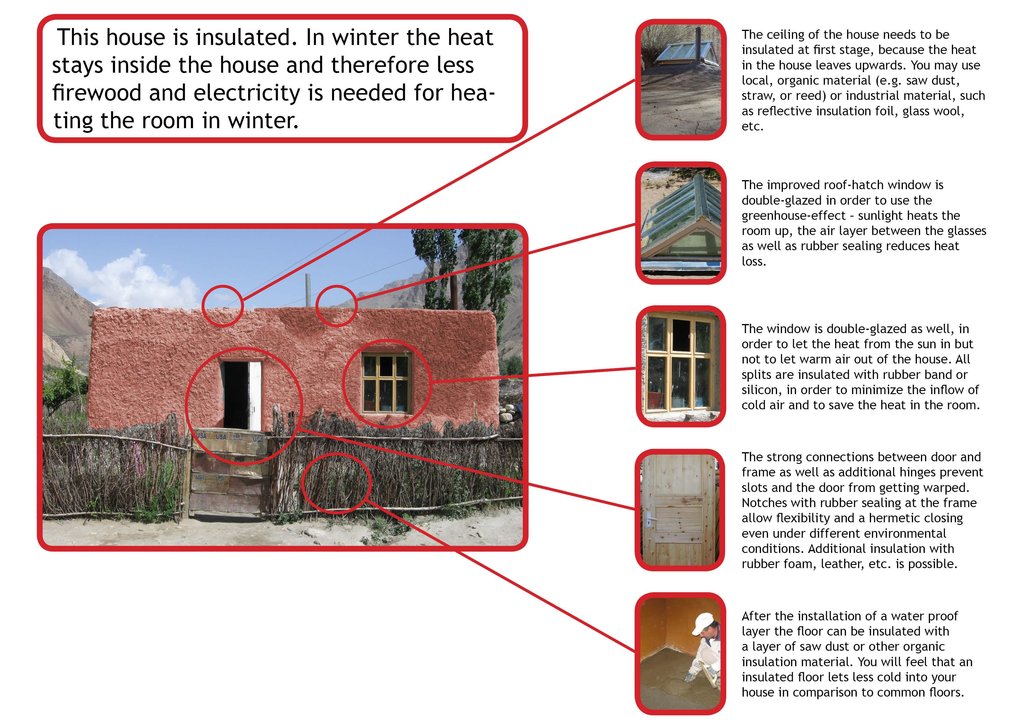Reduced pressure on forest resources by improved thermal insulation in private houses [Тажикистан]
- Шинийг нээх:
- Шинэчлэх:
- Эмхэтгэгч: Roziya Kirgizbekova
- Хянан тохиолдуулагч: –
- Хянагчид: Deborah Niggli, Alexandra Gavilano
Central Asian Countries Initiative for Land Management (CACILM/ИСЦАУЗР)
technologies_1459 - Тажикистан
- Бүрэн хураангуйн PDF хувилбар
- Бүрэн хураангуйг PDF-ээр хэвлэх
- Хөтөч дэх бүрэн хураангуй
- Бүрэн хураангуй (форматгүй)
- Reduced pressure on forest resources by improved thermal insulation in private houses: 04 1-р сар 2017 (inactive)
- Reduced pressure on forest resources by improved thermal insulation in private houses: 19 7-р сар 2017 (inactive)
- Reduced pressure on forest resources by improved thermal insulation in private houses: 20 8-р сар 2019 (inactive)
- Reduced pressure on forest resources by improved thermal insulation in private houses: 02 11-р сар 2021 (public)
Бүлгүүдийг үзэх
Бүгдийг дэлгэх Бүгдийг хаах1. Ерөнхий мэдээлэл
1.2 Технологийг үнэлэх, баримтжуулах ажилд хамаарах мэдээлэл өгсөн хүмүүс, байгууллагуудын холбоо барих мэдээлэл
ГТМ мэргэжилтэн:
Zevarshoev Rustam
Retail Cooperative "Zindagi"
Тажикистан
Технологи баримтжуулах/үнэлэх ажилд дэмжлэг үзүүлсэн төслийн нэр (шаардлагатай бол)
Central Asian Countries Initiative for Land Management (CACILM I)Технологи баримтжуулах/үнэлэх ажилд дэмжлэг үзүүлсэн төслийн нэр (шаардлагатай бол)
Pilot Program for Climate Resilience, Tajikistan (WB / PPCR)1.3 ВОКАТ-аар баримтжуулсан өгөгдлийг ашиглахтай холбоотой нөхцөл
Эмхэтгэгч болон гол мэдээлэгч хүн(хүмүүс) WOCAT аргачлалаар баримтжуулсан мэдээллийг ашиглахтай холбоотой нөхцлийг хүлээн зөвшөөрсөн:
Тийм
1.4 Технологи тогтвортой гэдгийг баталгаажуулах
Энэ технологийг газрын доройтлыг бууруулж, газрын тогтвортой менежментийг хангахад тохиромжтой гэж үзэж болох уу?
Үгүй
1.5 ГТМ Арга барилын Асуулга (ууд) руу хандах (ВОКАТ ашиглан баримтжуулсан)
2. ГТМ Технологийн тодорхойлолт
2.1 Технологийн товч тодорхойлолт
Технологийн тодорхойлолт:
Thermal insulation of private houses with energy efficient products to reduce the fuel-wood demand and pressures on the natural environment.
2.2 Технологийн дэлгэрэнгүй тодорхойлолт
Тодорхойлолт:
Well insulated doors and windows are installed together with thermal insulation of the ceilings and floors in houses in the remote villages of the Gorno-Badakhshan Autonomous Region. Improved quality windows and doors, as well as improved thermal insulation of the houses contribute to retain the heat inside, which is one of the main problems in many of these traditionally built houses. The quality of the materials used to produce the products as well as the quality of the product itself and its installation process are ensured through using locally trained craftsmen. Local available organic materials such as sawdust, straw, water plants, leaves and others can be used as thermal insulation material for walls, floors and ceilings. The materials should be dry and free of insects. The local labour market plays a crucial role in the technical accurate performance of the thermal insulation measures. Therefore the local labour market has to be analysed and training needs for the craftsmen have to be defined, e.g. for producing double-glazed windows and improved doors, as well as insulating walls, ceilings or floors, and the installation of windows and doors in accordance to the defined and standardised thermal insulation measu
Thermal insulation contributes to the reduction of heat exchange between indoors and outdoors and therefore may have two main effects: Less fuel may be needed to heat the houses, or using the same quantities of fuel the temperature indoors can be significantly increased. A reduction in fuel consumption means a reduction either of financial expenses or of labour, so the saved money or time can be used for other purposes - ideally for making investments and creating additional income sources. Higher and more constant indoor temperatures can contribute to a reduction in health risks and to increased quality of life during the winter period. Going beyond the level of the individual household, a reduction in fuel consumption means less pressure on natural resources: The less firewood that is used for heating, the less trees will be cut down and the less the forests will degrade. Also the less manure that is burnt in the stoves means more of it can be used as fertilizer on the arable land. In this framework many of the economical, social and environmental problems could be mitigated if houses were properly insulated.
A technical assessment of the identified house for thermal insulation is carried out to investigate which materials are used for the construction of the house, and to identify measures and materials that could be used for thermal insulation purposes, in order to be able to offer the most technically appropriate solution, which is adapted to the local cultural and climatic conditions. The organic thermal insulation material should be prepared in advance to make sure it is dry and clean. The designated area whether it is the floor, ceiling or walls should be cleared of furniture and other things items. Electric wires should be safely removed, or covered adequately for safety reasons to prevent fire. In the case of the roof, the insulation material is laid out evenly on the surface to a thickness of 15-20 cm depending on the type of organic material which is used. The lime is then spread out over the organic insulation material. For 1 m2 about 1-1.5kg of lime is required. The material is thoroughly tamped down to reduce subsidence of the protective cover, which will be put over the insulation material. A mixture of clay, straw and water is prepared to form a substance with a solid consistency to prevent the surface from cracking when it dries. This clay and straw mixture is then spread evenly on the surface about 4-6 cm thick, ensuring that the whole insulation material is covered. The surface should dry in 24 hours after which some cracks might appear and if this happens then a liquid mixture of clay and sand is used to flatten the area left to dry again. The same process is applied to the floors, and the more complex roof thermal insulation materials where roof felt is used as a basis for the organic insulation material as it is moisture proof. The windows and doors as well as these insulated areas in the house should be properly maintained. It should be ensures that there are no leaks in the roof so that the ceiling insulation is kept dry.
Riparian forests in the Western parts of Gorno-Badakhshan and Teresken shrubs on the high plains in the Eastern parts are almost completely destroyed due to their excessive use as a fuel for heating and cooking, and their overuse as areas for pastures. Manure, as one important natural fertilizer for agriculture, is no longer available in large quantities and so the fertility of soil has decreased. In the Eastern Pamirs, although the area is scarcely populated, Teresken shrubs have been used excessively as a fuel and are no longer found within 70km around the only major settlement of Murgab, which has resulted in massive soil erosion and degradation of pastures in this area. The situation is worsened by the fact that the local, mostly traditionally built houses are poorly insulated, low quality doors and windows do not preserve the heat inside during severe cold temperatures. Constant heating is thus necessary meaning households burn large amount of natural fuel resources to keep their houses warm. The thermal insulation technology should contribute to ease the pressure on the natural resources in the GBAO area and allow natural regeneration of forests and Teresken shrubs.
2.3 Технологийн гэрэл зураг
2.5 Энэ үнэлгээнд хамрагдсан технологийг хэрэгжүүлсэн улс орон/ бүс нутаг/ байршил
Улс:
Тажикистан
Улс/аймаг/сум:
Tajikistan, Gorno Badakhshan Autonomous Oblast (GBAO)
Байршлын дэлгэрэнгүй тодорхойлолт:
Roshtkala, Shugnan, Murgab and Ishkashim
Технологи өргөн дэлгэрсэн эсхийг тодорхойл:
- газар дээр жигд тархсан
Хэрэв талбайн хэмжээ тодорхойгүй бол талбайн хэмжээг ойролцоогоор тодорхойлно уу:
- 100-1,000 км2
Тайлбар:
The technology was implemented in several regions of GBAO.
Map
×2.6 Хэрэгжсэн хугацаа
Байгуулсан тодорхой оныг мэдэхгүй бол баримжаа хугацааг тодорхойл:
- <10 жилийн өмнө (саяхны)
2.7 Технологийн танилцуулга
Технологийг хэрхэн нэвтрүүлснийг тодорхойл:
- Гадны төсөл/хөтөлбөрийн дэмжлэгтэйгээр
Тайлбар (төслийн төрөл г.м.):
The technology was developed and introduced through GIZ project. Gradually Retail Cooperative "Zindagi", established by GIZ is taking the project over.
3. ГТМ технологийн ангилал
3.1 Технологийн үндсэн зорилго (ууд)
- үр ашигтай эдийн засгийн нөлөөг бий болгох
3.2 Технологи нэвтрүүлсэн газрын одоогийн газар ашиглалтын хэлбэр(үүд)

Байгалийн ой / модтой газар
- (Таримал) байгалийн ой/мод бүхий газар
(Сэргээсэн)байгалийн ой/тармаг ойд: Менежментийн төрлийг тодорхойлно уу:
- Сонгомол огтлол
Бүтээгдэхүүн ба үйлчилгээ:
- Мод бэлтгэл
- Түлшний мод
- Жимс, самар
- Бэлчээрийн талбай/Хариулгатай бэлчээрлэлт

Суурьшил, дэд бүтэц
- Эрчим хүч: дамжуулах хоолой, эрчим хүчний шугам сүлжээ
Тайлбар:
Major land use problems (compiler’s opinion): Due to a shortage of energy sources, wood, teresken and manure are extensively used for heating private houses; natural resources are therefore severely overused, which has resulted in degraded land, destroyed forests and lack of natural fertilizer for agriculture; poor thermal insulation of houses also leads to increased demand for fuel.
Major land use problems (land users’ perception): Unable to heat their houses properly during cold winters; shortage of fuel for cooking and heating; during cold winters, fire wood becomes so scarce that even fruit trees are cut down.
3.3 Технологи хэрэгжүүлснээр газар ашиглалтад өөрчлөлт гарсан уу?

Суурьшил, дэд бүтэц
3.5 Технологи ГТМ-ийн аль бүлэгт хамаарах вэ
- Эрчим хүч хэмнэх технологи
3.6 Технологийг бүрдүүлэх ГТМ арга хэмжээ

Ургамлын арга хэмжээ
- V5: Бусад

Барилга байгууламжийн арга хэмжээ
- S11: Бусад

Менежментийн арга хэмжээ
- М2: Ашиглалтын менежмент/эрчимийг өөрчлөх
3.7 Технологид харгалзах газрын доройтлын төрөл

хөрс усаар эвдрэх
- Wt: Хөрсний гадаргын угаагдал

биологийн доройтол
- Bc: Ургамлан нөмрөг багасах
- Bq: биомасс буурах
- Bs: Ургамлын чанар, төрөл зүйл, олон янз байдал буурах
Тайлбар:
Main causes of degradation: over-exploitation of vegetation for domestic use (Exploiting forest resources for heating and cooking.), poverty / wealth (Most people can't afford to buy other fuel such as coal or gas.), Lack of finances
Secondary causes of degradation: change in temperature (Extremely cold winters force people to cut down excessive amounts of wood for fuel), change of seasonal rainfall (Less precipitation), Heavy / extreme rainfall (intensity/amounts) (Heavy periods of rainfall), population pressure (Population growth leads to increasing demand for wood for fuel.), Destroyed infrastructure
3.8 Газрын доройтлоос урьдчилан сэргийлэх, сааруулах ба нөхөн сэргээх
Газрын доройтолтой холбоотойгоор Технологи ямар зорилго тавьсан болохыг тодорхойл:
- газрын доройтлоос урьдчилан сэргийлэх
4. Техникийн нөхцөл, хэрэгжүүлсэн үйл ажиллагаа, материал ба зардал
4.1 Технологийн техник зураг
Техник тодорхойлолт (техник зургийн тайлбар):
This diagram with photos shows the different thermal insulation measures.
Location: Ishkashim. Ishkashim, GBAO, Tajikisatan
Date: 26-02-2011
Technical knowledge required for field staff / advisors: high (Increased technical knowledge)
Technical knowledge required for craftsmen: high (Increased skills in producing well insulated doors and windows.)
Technical knowledge required for construction workers: high (Advanced skills in installation of thermal insulation products.)
Main technical functions: increase of biomass (quantity), Reduced heat loss from houses, Reduced fuel consumption
Secondary technical functions: improvement of topsoil structure (compaction), stabilisation of soil (eg by tree roots against land slides), increase in organic matter, increase in nutrient availability (supply, recycling,…), promotion of vegetation species and varieties (quality, eg palatable fodder)
Change of land use practices / intensity level
Зохиогч:
Tajikistan
4.2 Материал болон зардалд хамаарах ерөнхий мэдээлэл
бусад/үндэсний мөнгөн нэгж (тодорхойл):
somoni
Хэрэв боломжтой бол үндэсний валютын Америк доллартай харьцах харьцааг бичнэ үү (тухайлбал, 1 ам.дол. = 79,9 Бразил реал): 1 ам.дол. =:
4.6
4.3 Бий болгох үйл ажиллагаа
| Үйл ажиллагаа | Хугацаа (улирал) | |
|---|---|---|
| 1. | Installation of window 1.40x1.30 | Any time |
| 2. | Installation of door 2.00x0.90 | |
| 3. | Thermal insulation |
4.4 Бий болгоход шаардагдсан зардал, хөрөнгийн өртөг
| Зардлын нэр, төрөл | Хэмжих нэгж | Тоо хэмжээ | Нэгжийн үнэ | Зардал бүрийн нийт өртөг | Нийт дүнгээс газар ашиглагчийн төлсөн % | |
|---|---|---|---|---|---|---|
| Хөдөлмөр эрхлэлт | labour | ha | 1.0 | 17.0 | 17.0 | 100.0 |
| Барилгын материал | door | ha | 1.0 | 133.0 | 133.0 | 100.0 |
| Барилгын материал | window | ha | 1.0 | 126.0 | 126.0 | 100.0 |
| Барилгын материал | Isolation material | ha | 1.0 | 126.0 | 126.0 | 100.0 |
| Технологи бий болгох нийт үнэ өртөг | 402.0 | |||||
| Технологи бий болгох нийт үнэ өртөг, ам.доллар | 87.39 | |||||
4.6 Арчилгаа/урсгал ажилд шаардагдсан зардал, хөрөнгийн өртөг (нэг жилд)
Тайлбар:
The labour costs are indicated for installation of one window/door. With regards to the thermal insulation the labour costs are higher, so they are calculated per square metre of the area where thermal insulation will be applied.
4.7 Зардалд нөлөөлж байгаа хамгийн чухал хүчин зүйл
Өртөг, зардалд нөлөөлөх гол хүчин зүйл:
The costs for the installation of windows and doors depends on their size and also whether additional work has to be done to fit the door or window hatch to the required size. With regards to the thermal insulation the costs are estimated based of the size of the area in square metres, whether it is the floor, ceiling or wall.
5. Байгаль ба нийгмийн нөхцөл
5.1 Уур амьсгал
Жилийн нийлбэр хур тундас
- < 250 мм
- 251-500 мм
- 501-750 мм
- 751-1,000 мм
- 1,001-1,500 мм
- 1,501-2,000 мм
- 2,001-3,000 мм
- 3,001-4,000 мм
- > 4,000 мм
Хур тунадасны талаархи тодорхойлолт/ тайлбар:
In Murghab District annual rainfall is below 200mm. Around Khorog annual rainfall is 480mm.
Агро-уур амьсгалын бүс
- хуурай
Thermal climate class: temperate, boreal
5.2 Гадаргын хэлбэр
Дундаж налуу:
- хавтгай (0-2 %)
- бага зэрэг налуу (3-5 %)
- дунд зэрэг налуу (6-10 % )
- хэвгий (11-15 %)
- налуу (16-30 %)
- их налуу (31-60 % )
- эгц налуу (>60 %)
Гадаргын хэлбэр:
- тэгш өндөрлөг / тал
- нуруу
- уулын энгэр
- дов толгод
- бэл
- хөндий
Өндрийн бүслүүр:
- 0-100 д.т.д. м.
- 101-500 д.т.д. м.
- 501-1,000 д.т.д м.
- 1,001-1,500 д.т.д м.
- 1,501-2,000 д.т.д м.
- 2,001-2,500 д.т.д. м.
- 2,501-3,000 д.т.д. м.
- 3,001-4,000 д.т.д м.
- > 4,000 д.т.д. м.
5.3 Хөрс
Хөрсний дундаж зузаан:
- маш нимгэн (0-20 см)
- нимгэн (21-50 см)
- дунд зэрэг зузаан (51-80 см)
- зузаан (81-120 cм)
- маш зузаан (>120 cм)
Хөрсний бүтэц (өнгөн хөрс):
- бүдүүн/ хөнгөн (элсэрхэг)
Өнгөн хөрсөнд агуулагдах ялзмаг:
- дунд (1-3 % )
- бага (<1 % )
5.4 Усны хүртээмж ба чанар
Гүний усны түвшин:
5-50 м
Гадаргын усны хүртээмж:
сайн
Усны чанар (цэвэршүүлээгүй):
сайн чанарын ундны ус
5.5 Биологийн олон янз байдал
Зүйлийн олон янз байдал:
- Их
5.6 Технологи нэвтрүүлсэн газар ашиглагчдын тухай мэдээлэл
Үйлдвэрлэлийн системийн зах зээлийн чиг баримжаа:
- амь зуух арга хэлбэрийн (өөрийгөө хангах)
Бусад эх үүсвэрээс олох орлого:
- Нийт орлогын 50 %-иас дээш
Чинээлэг байдлын түвшин:
- ядуу
- дундаж
Хувь хүн эсвэл бүлэг:
- Хувь хүн / өрх
Хүйс:
- эмэгтэй
- эрэгтэй
Газар ашиглагчдын бусад шинж чанарыг тодорхойл:
Land users applying the Technology are mainly Leaders / privileged
Population density: 10-50 persons/km2
Annual population growth: 2% - 3% (If creditworthy, they can participate through micro-loans schemes.).
Off-farm income specification: The majority of households rely heavily on remittances from Russia.
5.7 Газар ашиглагчийн технологи нэвтрүүлсэн газрын дундаж талбайн хэмжээ
- < 0.5 га
- 0.5-1 га
- 1-2 га
- 2-5 га
- 5-15 га
- 15-50 га
- 50-100 га
- 100-500 га
- 500-1,000 га
- 1,000-10,000 га
- > 10,000 га
Энэ талбай том, жижиг, дунд алинд хамаарах вэ (орон нутгийн нөхцөлд харгалзуулна уу)?
- бага-хэмжээний
5.8 Газар эзэмшил, газар ашиглах эрх, ус ашиглах эрх
Газар өмчлөл:
- төрийн
Газар ашиглах эрх:
- түрээсийн хэлбэрээр
5.9 Дэд бүтэц, үйлчилгээний хүртээмж
эрүүл мэнд:
- ядуу
- дунд зэргийн
- сайн
боловсрол:
- ядуу
- дунд зэргийн
- сайн
техник зөвлөгөө:
- ядуу
- дунд зэргийн
- сайн
хөдөлмөр эрхлэлт (жишээ нь, ХАА-аас өөр):
- ядуу
- дунд зэргийн
- сайн
зах зээл:
- ядуу
- дунд зэргийн
- сайн
эрчим хүчний хангамж:
- ядуу
- дунд зэргийн
- сайн
зам тээвэр:
- ядуу
- дунд зэргийн
- сайн
усан хангамж ба ариутгал:
- ядуу
- дунд зэргийн
- сайн
санхүүгийн үйлчилгээ:
- ядуу
- дунд зэргийн
- сайн
6. Үр нөлөө ба дүгнэлт
6.1 Технологийн талбайд үзүүлсэн нөлөө
Нийгэм-эдийн засгийн үр нөлөө
Үйлдвэрлэл
тэжээл үйлдвэрлэл
тэжээлийн чанар
малын бүтээмж
Орлого, зарлага
тухайн аж ахуйн орлого
Тайлбар/ тодорхой дурьдах:
Save money from buying fuel and electricity
орлогын олон янз эх үүсвэр
Тайлбар/ тодорхой дурьдах:
Income of craftsmen increased.
ажлын хэмжээ
Тайлбар/ тодорхой дурьдах:
Less time needed for fire wood collection
Нийгэм-соёлын үр нөлөө
эрүүл мэндийн байдал
Тайлбар/ тодорхой дурьдах:
Warmer houses reduce health risks.
ГТМ/ газрын доройтлын мэдлэг
Тайлбар/ тодорхой дурьдах:
Improved knowledge on energy efficiency and insulation measures.
маргааныг шийдвэрлэх
нийгэм, эдийн засгийн хувьд эмзэг бүлгийнхний нөхцөл байдал
Тайлбар/ тодорхой дурьдах:
Opportunity to improve living conditions and save money.
contribution to human well-being
Тайлбар/ тодорхой дурьдах:
In general, people save money on energy sources and spend less time collecting wood and animal dung from the field. Houses are warmer, which can be beneficial for the family's health.
Экологийн үр нөлөө
Усны эргэлт/ илүүдэл
гадаргын урсац
ууршилт
Хөрс
хөрсний чийг
хөрсөн бүрхэвч
Биологийн олон янз байдал: ургамал, амьтан
газрын дээрхи / доорхи карбон
Тайлбар/ тодорхой дурьдах:
Up to 45% less wood used for fuel.
ургамлын төрөл, зүйл
амьдрах орчны олон янз байдал
Тайлбар/ тодорхой дурьдах:
In Murghab District teresken used as fire wood is the main fodder for wild animals (e.g. deer, gazelles)
6.2 Технологийн талбайн гадна үзүүлсэн үр нөлөө
хуурай улиралд ашиглах найдвартай, тогтвортой урсац
Тайлбар/ тодорхой дурьдах:
Protection of riparian forests.
голын адагт үерлэх
Тайлбар/ тодорхой дурьдах:
Protection of riparian forests.
буферлэх / шүүлтүүрийн багтаамж
салхиар тээвэрлэгдэх хурдас
хөрш зэргэлдээ газарт учирах хохирол
нийтийн/хувийн хэвшлийн дэд бүтцэд учрах хохирол
6.3 Технологийн уур амьсгалын өөрчлөлт, цаг агаарын гамшигт үзэгдэлд өртөх байдал ба эмзэг байдал (газар ашиглагчийн бодлоор)
Уур амьсгалын аажим өөрчлөлт
Уур амьсгалын аажим өөрчлөлт
| Улирал | Өсөх эсвэл буурах | Технологи түүний нөлөөг хэрхэн бууруулж байна? | |
|---|---|---|---|
| жилийн дундаж температур | Өсөлт | сайн |
Уур амьсгалаас хамаарах аюул (гамшиг)
Цаг уурын гамшигт үзэгдэл
| Технологи түүний нөлөөг хэрхэн бууруулж байна? | |
|---|---|
| орон нутгийн аадар бороо | сайн |
| орон нутгийн салхин шуурга | мэдэхгүй |
Уур амьсгалын гамшиг
| Технологи түүний нөлөөг хэрхэн бууруулж байна? | |
|---|---|
| ган гачиг | сайн |
Усзүйн гамшиг
| Технологи түүний нөлөөг хэрхэн бууруулж байна? | |
|---|---|
| усны үер (гол) | мэдэхгүй |
Уур амьсгалд хамаарах бусад үр дагавар
Уур амьсгалд хамаарах бусад үр дагавар
| Технологи түүний нөлөөг хэрхэн бууруулж байна? | |
|---|---|
| цргалтын хугацаа багасах | сайн |
| Extreme cold temperatures | сайн |
6.4 Өртөг ба ашгийн шинжилгээ
Бий болгох зардалтай харьцуулахад ямар ашиг өгсөн бэ (газар ашиглагчийн бодлоор)?
Богино хугацаанд эргэн төлөгдөх байдал:
бага зэрэг эерэг
Урт хугацаанд эргэн төлөгдөх байдал:
эерэг
Арчилгаа/урсгал зардалтай харьцуулахад ямар ашиг өгсөн бэ (газар ашиглагчийн бодлоор)?
Богино хугацаанд эргэн төлөгдөх байдал:
маш эерэг
Урт хугацаанд эргэн төлөгдөх байдал:
маш эерэг
6.5 Технологи нэвтрүүлэлт
Тайлбар:
168 land user families have adopted the Technology without any external material support
The households take a micro loan with an affordable low interest rate to install thermal insulation products. The micro loan is not provided in the form of cash, but in kind, i.e. the products and installation.
There is a moderate trend towards spontaneous adoption of the Technology
Comments on adoption trend: When one household installs quality windows or doors or has its house insulated, the effects are visible not only to that given household but also to neighbours and other visitors. As a result the number of people interested in installing such technology to their homes is increasing.
6.7 Технологийн давуу тал/боломжууд
| Газар ашиглагчдын тодорхойлсон давуу тал/боломжууд |
|---|
| Costs of firewood reduced |
| Warm and comfortable houses |
| Reduced workload |
| Эмхэтгэгч, бусад мэдээлэл өгсөн хүмүүсийн өнцгөөс тодорхойлсон давуу тал/боломжууд |
|---|
| If implemented on a larger scale can prevent overuse of natural resources for fuel. |
| Incentives in form of micro loans to make the technology more accessible to local people. |
| Reduced workload and costs spent on buying fuel. |
| Imported timber used to produce doors and windows. |
| More fertilizer available. |
6.8 Технологийн дутагдалтай/сул тал/аюул болон тэдгээрийг хэрхэн даван туулах арга зам
| Эмхэтгэгч, бусад мэдээлэл өгсөн хүмүүсийн өнцгөөс тодорхойлсон сул тал/ дутагдал/ эрсдэл | Тэдгээрийг хэрхэн даван туулах вэ? |
|---|---|
| Lack of skilled craftsmen | Improved professional craftsmen education through training courses. |
| Lack of modern equipment to produce wooden products | Financial support to supply the local craftsmen with modern equipment to further improve the quality of the products and increase the rate the production process. |
7. Ном зүй ба холбоосууд
7.1 Мэдээлэл цуглуулсан арга/эх үүсвэр
- Хээрийн уулзалт, судалгаа
- Газар ашиглагчтай хийсэн ярилцлага
Мэдээллийг хэзээ (газар дээр нь) цуглуулсан бэ?
24/01/2011
Холбоос ба модулууд
Бүгдийг дэлгэх Бүгдийг хаахХолбоосууд
Холбоос байхгүй байна
Модулууд
Модуль байхгүй байна


